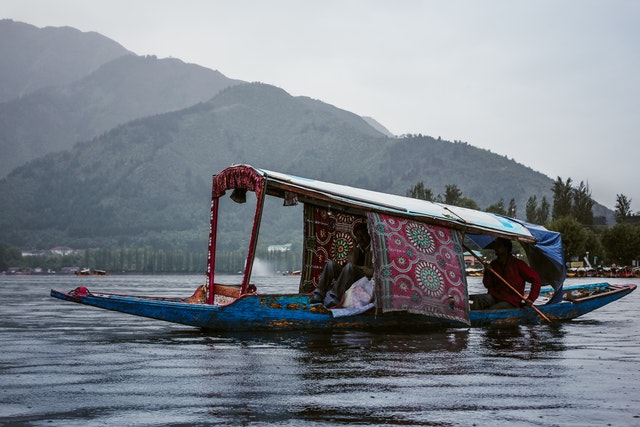Why Was Article 370 Not Abrogated Earlier?
Blogs | 5 Minute

“Article 370 is neither a wall nor a mountain, but…it is a tunnel. It is through this tunnel that a good deal of traffic has already passed and more will.”
Gulzarilal Nanda
In 1950, the State of J&K was included in the Union of India on the basis of Article 370 – a ‘temporary’ provision. But in the course of time, this ‘temporary’ provision became more or less permanent, staying on the books for almost 70 years. How did this come to be? The answer is simple: Article 370 was retained as a matter of legal convenience.
Examining ‘temporary’
In 1949, when the drafting of the Indian Constitution was nearing completion, a significant issue arose – the constitutional position of J&K within the new Union of India remained indeterminate. Earlier, in 1947, by virtue of signing an ‘Instrument of Accession’, J&K – like all the other erstwhile Princely States of India – had become a part of India. However, between 1947 and 1949, while all other Princely States signed further Instruments of Accession (giving up their functional autonomy entirely) J&K did not do so. This meant that as of November 1949, in law, the State of J&K was attached to the Union of India only in three aspects: defense, communications and international relations.
In this context, Article 370 was formulated as a means of onboarding J&K into the Union of India. The Constitution of India was to be brought into force, and it could not omit making a reference to J&K. But since J&K position within India was still up for debate, it was decided to formulate a ‘temporary’ provision – Article 370 – which would tether J&K to India under the Indian Constitution.
Article 370, simply put, said that the constitutional relationship between India and J&K would remain in flux until the Constituent Assembly of J&K made a final determination as to the position of J&K within India. Effectively, this was a mechanism designed to capture the ‘will of the people’ of J&K in the question of their constitutional destiny. Meanwhile, until this determination was made, it was decided that for the sake of pragmatism, the Government of J&K and the Government of India would be allowed to come to common consensus and alter the constitutional relationship between J&K and India by executive order. This pragmatic power was contained within Article 370.
With this background it becomes clear what it meant for Article 370 to be ‘temporary’ in the first place. Contrary to popular opinion, even at the time of its framing, Article 370 did not signify that the ‘special status’ of J&K (i.e. its relative constitutional autonomy) within India would be a temporary phenomenon. It did not signify that the J&K would enjoy an autonomous position within India for a temporary period.
Rather, ‘temporary’ only meant that the J&K and India relationship would be temporarily defined until J&K could decide for itself what its desired constitutional position within India would be. In theory, this did not preclude J&K from making a determination that it would like to permanently enjoy constitutional autonomy within India.
Simply put, ‘temporary’ was a reference to an interim period immediately after the framing of the Constitution, where J&K’s constitutional relationship with India would remain in flux. This state of flux would remain until the Constitutional Assembly of J&K could make a final determination about its desired position within India. This is what the legal position signified.
1957: Constituent Assembly of J&K dissolves without giving permanence to the relationship
The Constituent Assembly of J&K was elected by universal adult franchise in 1951. In 1954, it ratified the state’s accession to India, and in 1956 it adopted the Constitution of J&K. In doing so, J&K gave definition to its desired position within India and its desired constitutional relationship with India.
The determination made by the Constituent Assembly of J&K made the state a firm and inalienable part of India. However, at the same time, this determination also retained a significant degree of functional autonomy for the State. It was determined that J&K would have its own locally elected Head of State, who could only be a citizen of J&K. Bureaucrats in the state government would also only be recruited only from the state’s population, and these positions would not be open to individuals from the rest of the country. The Supreme Court of India would have limited jurisdiction over J&K, and so would the Election Commission of India. J&K would not participate in the national general election, but rather, would send its Lok Sabha representatives via election in its state legislature.
Now that the Constituent Assembly of J&K has given definition to the constitutional position of J&K within India, the stated utility and purpose of Article 370 had arguably been fulfilled. It was no longer necessary to keep the constitutional relationship between J&K and India in flux – and the ‘pragmatic power’ conferred on the Governments of J&K and India to alter the relationship by executive order, was no longer necessary. At this stage, Article 370 should have been abrogated, giving final permanence to the position of J&K within India.
The prerogative to dissolve Article 370 had been placed in the combined hands of the Constituent Assembly of J&K and the Government of India. A recommendation from the Assembly would empower the Government of India to abrogate Article 370 and that would be the end of it. The Constituent Assembly however, never made such a recommendation. Consequently, the Government of India never issued the order to abrogate Article 370. In 1957 therefore, when the Constituent Assembly dissolved, Article 370 remained in the Constitution of India.
The continued existence of Article 370 had one major implication: the ‘pragmatic power’ to alter the constitutional relationship between J&K and India remained in play. Hence, the constitutional position of J&K within India continued to remain in flux. The Constituent Assembly of J&K’s determination of its autonomous position within India was not set in stone, and Article 370’s continued existence allowed for this autonomy to be eroded over time.
1964: An attempt at abrogation makes clear why Article 370 was retained
In December 1963, the streets of Srinagar witness a popular uprising of a magnitude not seen since before independence. The theft of a religious relic – the Moi-e-Muqqdas – from the Hazratbal shrine triggered discontent amongst the people, and they took to the streets in large numbers. The incident also provided an outlet for the people to express their displeasure with the maladministration of the State over the course of the last decade. In this bedlam, the Plebiscite Front – a pro-independence faction of local politicians – found an opportune moment to raise anti-India slogans.
The Hazratbal incident caught the country by storm. It was clear that the people of J&K were dissatisfied with the state of affairs prevalent in J&K. Remedial action for this situation was necessary. Consequently, in 1964, Parliament decided to consider taking action on the matter. In September 1964, MP Prakash Vir Shashtri presented a Bill in the Lok Sabha proposing the abrogation of Article 370. Speaking vehemently in its favour, Shashtri decried the continued existence of the ‘special status’ of J&K and demanded that it be put to an end. Over the course of deliberations, Shashtri’s position received widespread (almost unanimous) support from the House, across party lines. Most notably, Members from the State of J&K also supported the motion, with one of them stating that Article 370 relegated the people of J&K to the status of ‘second class citizens’.
In the course of these deliberations, Article 370 had been described as a ‘wall of separation’ between India and J&K by one Member of the House. Another Member doubled down on this analogy, calling Article 370 “a big mountain which stands between India and J&K”. By the end of deliberations, it was clear that the House unanimously wanted the abrogation of Article 370. It seemed unlikely that the provision would survive for much longer.
At this stage, Union Home Minister Gulzarilal Nanda took the floor and delivered the government’s response. He first acknowledged that the Bill had received wide support from the House, and then stated that the Government was in general agreement with the ‘essential purpose underlying the motion’. But in spite of this alignment in objective, Nanda stated that abrogating Article 370 would not fulfill the purpose sought to be achieved by the Bill, but rather would defeat it.
Picking up the analogy from earlier, Nanda clarified with the following words: “Article 370 is neither a wall nor a mountain, but…it is a tunnel. It is through this tunnel that a good deal of traffic has already passed and more will.” He stated that abrogating Article 370 would not automatically amount to the full integration of J&K with India. Rather, his position was that retaining Article 370 was essential to continue the gradual integration of J&K with India.
What Nanda was referring to here was the ‘pragmatic power’ to alter the constitutional relationship between J&K and India, that had remained on the books when Article 370 was not abrogated in 1957. This power empowered the Government of J&K and the Government of India to come to consensus and alter the constitutional relationship between J&K and India in a piecemeal manner, by a simple executive order. In arguing for the retention of Article 370, Nanda was effectively making the case that the continued existence of Article 370 allowed the Government of India to extend Union jurisdiction over J&K bit-by-bit, without ruffling any feathers. This was the primary reason why Article 370 was retained on the books for so long.
Article 370: a tunnel in a wall
The continued existence of Article 370 allowed for the integration of J&K with India in a piecemeal manner. It allowed for the functional autonomy that the Constituent Assembly of J&K had retained for itself in 1956 to be chipped away in the years that followed.
By the late 1960s for instance, J&K was already participating in the General Election; the Election Commission obtained jurisdiction over J&K; and so did the Supreme Court. The special office of a locally elected Head of State in J&K was abolished and it was replaced with a centrally appointed Governor, as was the norm in other States. The office of the ‘Prime Minister’ of J&K was also abolished and replaced with the standard ‘Chief Minister’. J&K was brought within the ambit of Articles 356 and 357 of the Indian Constitution, making it possible for the Union Government to impose ‘President’s Rule’ in the State. All these actions were made possible only as a result of the continued existence of Article 370.
As fate would have it, many of the pricemeal changes that integrated J&K with India over the years (like enabling President’s Rule) proved integral to the legal setting which was used to abrogated Article 370 in 2019. Had it not been for the earlier changes, the abrogation of Article 370 in 2019 would have been an altogether different challenge.

